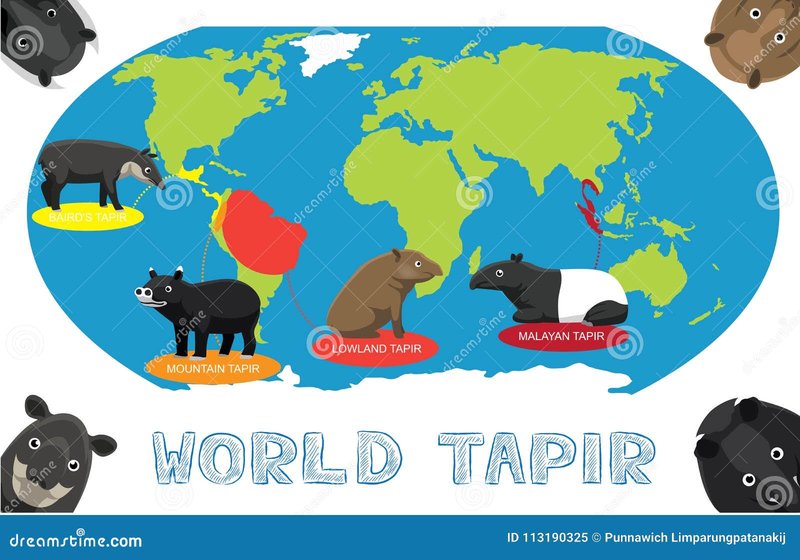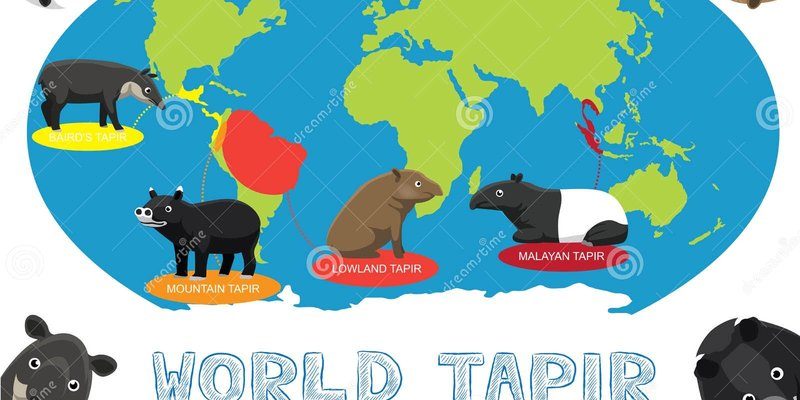
Baird’s tapirs, named after the American naturalist Spencer Fullerton Baird, are found primarily in Central America. They’re like the shy neighbors of the rainforest, often elusive and hard to spot. So, if you’re curious about their *habitat and distribution*, you’re in the right place! Here’s what you need to know about where Baird’s tapirs call home and how their environment shapes their lives.
What Is Baird’s Tapir?
Before we zoom into their habitat, let’s clarify what Baird’s tapir is. They are the largest land mammals in Central America and can weigh between 400 to 600 pounds. With their distinctive body shape, short legs, and flexible snouts, they definitely stand out in the animal kingdom. Think of them as the gentle giants of the forest.
Baird’s tapirs have a very dark brown to black coat with lighter markings, especially on younger individuals. This unique coloring helps them blend into their lush surroundings, making it easier for them to hide from predators. Honestly, their camouflage is quite impressive—it’s like nature designed them specifically for a life among trees, shadows, and splashes of sunlight.
Natural Habitat of Baird’s Tapirs
Baird’s tapirs thrive in a range of habitats, but they prefer areas that provide a mix of dense forests and open spaces. You’ll typically find them in:
- Lowland tropical rainforests
- Cloud forests
- Swamps and wetlands
- Riverside areas
These habitats offer plenty of food—mostly leaves, fruits, and aquatic plants—which makes it easy for Baird’s tapirs to graze. They have a knack for navigating through thick vegetation, munching on foliage and fruits as they go. Also, being close to water is crucial for them. Not only do they enjoy a good swim, but they also rely on streams for hydration.
Geographical Distribution
Now that we have an idea of their habitat, let’s talk about where you can find these fascinating creatures. Baird’s tapirs are primarily distributed from southern Mexico down through Central America, reaching as far as Colombia and Venezuela in South America. Here’s a quick breakdown:
- Mexico: They are found in the southern regions, especially in areas like Chiapas.
- Central America: Countries like Guatemala, Belize, Honduras, Nicaragua, Costa Rica, and Panama are home to Baird’s tapirs.
- South America: Their range extends into Colombia, where they inhabit the lowland areas.
It’s pretty wild to think of them roaming through jungles and riverbanks, isn’t it? Unfortunately, their numbers are declining in some regions due to habitat destruction and hunting, which makes knowing their current distribution even more important.
Threats to Their Habitat
Just like many animals, Baird’s tapirs face several threats that impact their natural habitat. Deforestation is a big issue. As humans clear forests for agriculture and development, these gentle mammals lose their homes. This loss disrupts their access to food and water, making survival harder.
Another key threat is hunting. Baird’s tapirs have been hunted for their meat and hides, which further decreases their population. Honestly, it’s heartbreaking to think about how their quiet existence is threatened by human activities. Conservation efforts are vital in protecting these beautiful creatures and their habitats from such dangers.
Conservation Status
Baird’s tapirs are classified as near threatened on the IUCN Red List due to their declining population. They are certainly not at the brink of extinction, but their numbers are worrying. Conservationists are working hard to preserve their habitats and promote awareness about the necessity of protecting these unique animals.
Efforts include establishing protected areas in their range and creating corridors that allow tapirs to move between habitats safely. You might be wondering how you can help. Supporting conservation organizations and educating others about tapirs can make a significant difference.
Why Their Habitat Matters
You might be thinking, “Why should I care about where Baird’s tapirs live?” Well, their habitat is crucial not just for their survival but also for the entire ecosystem they inhabit. These gentle giants play a vital role in seed dispersal. As they munch on various plants and fruits, they help in spreading seeds across the forest floor. This process supports the growth of new plants and maintains a healthy environment.
In essence, protecting Baird’s tapirs means protecting the forests and wetlands they help sustain. It creates a ripple effect that benefits countless other species, too. By maintaining biodiversity, we’re also helping our planet thrive.
How We Can Help Baird’s Tapirs
If you’re as intrigued by Baird’s tapirs as I am, there are plenty of ways to step in and help. Here are some simple actions:
- Spread Awareness: Share information about Baird’s tapirs with friends and family. The more people know, the better!
- Support Conservation Groups: Consider donating to organizations focused on protecting Baird’s tapirs and their habitats.
- Responsible Tourism: If you’re visiting regions where these tapirs live, choose eco-friendly tours that support conservation.
By taking these steps, you can contribute to the survival of this one-of-a-kind species and help preserve their lush environments.
In conclusion, Baird’s tapirs are extraordinary creatures with a unique place in their habitats. Learning about where they live and the challenges they face helps us appreciate them even more. So next time you think about these gentle giants, remember their home in the vibrant rainforests of Central America and the role they play in keeping those ecosystems alive. Together, we can make a difference for Baird’s tapirs and the delicate balance of nature they help maintain.

